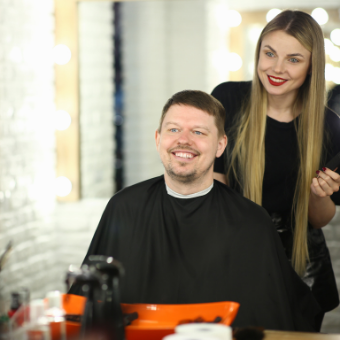As unique hair professionals with diversified talents, interests, and work preferences, we don’t all share the same definition of an “ideal client.” One stylist may enjoy gray coverage or the weekly roller set as an ideal clientele, while another gets giddy over vivid colors and new trends. However, what all hair professionals can agree upon is the “perfect client.”
The perfect client shows up for their appointments on time, has realistic expectations, and an appreciation for our professional recommendations. They purchase home-care products and prebook their maintenance appointment. That would be perfect, right? Ideal clients can be gained through strategic marketing, but perfect clients are “trained” by our professionalism behind the chair and the experience we provide them. If your clients are less than perfect, take a look at your own behavior. Clients are trained by what they experience in the salon.
1. SHOWING UP ON TIME
If you’re always running late, or always rebooking a set appointment, don’t be surprised when your clients begin showing up late or worse, deciding to rebook with another stylist. Why would they try to be on time when they know from experience that they’ll most likely have to wait for you to finish the client ahead of them? Why would they honor an appointment if you always rebook their appointment because you must constantly adjust your schedule? When you’re not on time for your clients, you forfeit any right to ever mention their tardiness or, heaven forbid, have repercussions for tardiness when it inconveniences your schedule. Respect works both ways.
2. HAVING REALISTIC EXPECTATIONS AND TAKING RECOMMENDATIONS .png)
Clients with unrealistic expectations for their hair are simply ignorant . . . or are they? Is it possible they just don’t know about hair? How it works, how the hair is structured, how they cannot color their hair with box dye and expect to have platinum hair in two hours? Chances are, they simply have not been educated about the science of hair and service processes. Are you sharing your education and expertise? Obviously, educating clients during the consultation and discussing the process throughout the service is huge. But establishing credibility and educating clients is a process. Try blogging, sharing informational social media posts, creating tutorials, sending out a client newsletter, or educating at a local event. All these methods help get good education out to consumers, establish your expertise, heighten value in the services you provide, and add weight behind your recommendations. One of the biggest impacts we can have as professionals is educating our guests the moment they sit down in our chair. It all begins with the consultation. It then extends to the shampoo bowl, during styling, and yes, even as they are leaving and purchasing the recommended home-care products you have already educated them on from the moment they sat down.
3. PURCHASING HOME CARE
Be honest: Are you guilty of expecting your clients to purchase home-care products from you when you haven’t even “prescribed” anything? Prescribing and offering are very different. Doctors prescribe products they believe are necessary to fix a patient’s ailments. They tell you what you need, why you need it, what it will do, and exactly how to use it. Prescribing is not a pushy sales pitch that turns people off; it is a service. Someone only turns down a doctor’s prescription if they truly cannot afford it, already have some of the exact prescription at home, or are completely homeopathic. It is now commonplace and expected that a doctor’s visit will result in a helpful prescription, and this result is often why someone sees a doctor in the first place. Simply throwing out, “Do you need any products today?” does very little, if anything, to train clients to purchase home care from you like they do from big pharma. But when we educate and explain the why and how behind it, it is no longer a sales pitch, it is a prescribed shampoo to extend the color you just spent three hours completing, the hair mask you are prescribing to help the integrity of their hair, and the styling aids prescribed so they can duplicate the same look you just gave them.
4. PREBOOKING FOLLOW-UP APPOINTMENTS 
We are in a service industry, so some accommodations should be made to provide excellent service to our clients. However, if you are bending over backward and working extra hours at the expense of your family or your health to squeeze in the same clients who don’t take prebooking—or your time—seriously, that’s no longer “good service.” That is enabling bad client behavior at your own expense. And it’s on you to decide if this good for you and your business. Jumping back to Are you constantly running behind because you squeezed in that client last minute, making the rest of your day fall behind? That displays bad customer service for every client who was on time but had to wait for their appointment. Quit enabling and start training clients to prebook immediately after their appointment—just as a perfect client would. By prebooking, you are building your business with time management.
If you’re still working to build a full book, that doesn’t mean you have to be available at any random time. Every time a hair professional posts, for the seventh time in a week, that they have openings in their book, a pair of shears dies! No, but really, how do you expect your clients to learn it’s important to prebook their appointments when you’re constantly promoting on social media that anyone can get in whenever they please? There’s no demand there. Prebooking clients helps increase their frequency of visits, filling in those gaps in your schedule. Promote yourself without diminishing the implicit demand for your services so clients are trained to prebook.
How you conduct your business, speak to clients, and carry yourself behind the chair directly affects how clients respond to you. If you want that perfect client, some training is necessary. Before you get the urge to fire every client in your book, evaluate your own behavior (which is really the only thing you can control). Ideal clients can be gained through strategic marketing, but perfect clients are trained by your professionalism behind the chair.
